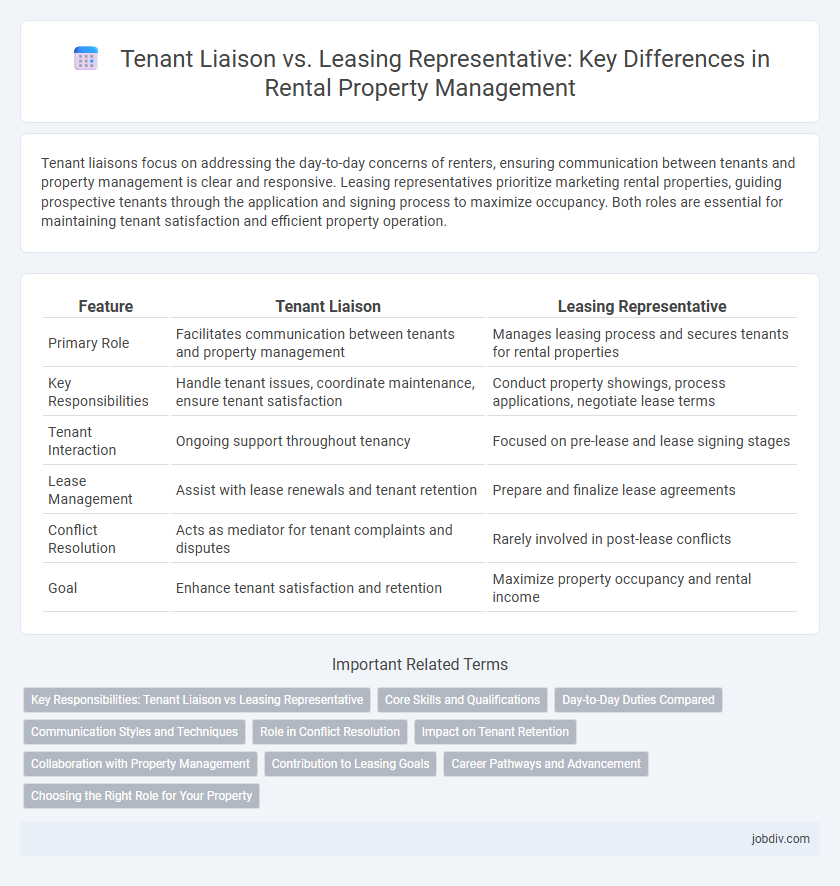Tenant liaisons focus on addressing the day-to-day concerns of renters, ensuring communication between tenants and property management is clear and responsive. Leasing representatives prioritize marketing rental properties, guiding prospective tenants through the application and signing process to maximize occupancy. Both roles are essential for maintaining tenant satisfaction and efficient property operation.
Table of Comparison
| Feature | Tenant Liaison | Leasing Representative |
|---|---|---|
| Primary Role | Facilitates communication between tenants and property management | Manages leasing process and secures tenants for rental properties |
| Key Responsibilities | Handle tenant issues, coordinate maintenance, ensure tenant satisfaction | Conduct property showings, process applications, negotiate lease terms |
| Tenant Interaction | Ongoing support throughout tenancy | Focused on pre-lease and lease signing stages |
| Lease Management | Assist with lease renewals and tenant retention | Prepare and finalize lease agreements |
| Conflict Resolution | Acts as mediator for tenant complaints and disputes | Rarely involved in post-lease conflicts |
| Goal | Enhance tenant satisfaction and retention | Maximize property occupancy and rental income |
Key Responsibilities: Tenant Liaison vs Leasing Representative
Tenant Liaisons primarily handle communication between tenants and property management, addressing concerns, coordinating maintenance requests, and ensuring tenant satisfaction to maintain positive relationships and reduce turnover. Leasing Representatives focus on marketing rental properties, conducting property tours, processing applications, and executing lease agreements to maximize occupancy and revenue. Both roles are essential in property management, with Tenant Liaisons emphasizing tenant retention and Leasing Representatives driving new tenant acquisition.
Core Skills and Qualifications
Tenant Liaisons excel in communication, conflict resolution, and tenant advocacy, ensuring tenant satisfaction and seamless issue management. Leasing Representatives focus on sales skills, market knowledge, and customer service, driving property occupancy through effective tenant screening and lease negotiations. Both roles require strong interpersonal abilities but differ in emphasis on tenant relations versus leasing transactions.
Day-to-Day Duties Compared
Tenant liaisons handle day-to-day communication with residents, addressing maintenance requests, resolving conflicts, and ensuring tenant satisfaction to promote retention. Leasing representatives focus on marketing rental units, conducting property tours, processing applications, and finalizing lease agreements to secure new tenants. Both roles collaborate closely but prioritize tenant relations versus lease acquisition in their daily responsibilities.
Communication Styles and Techniques
Tenant Liaisons employ personalized communication techniques, prioritizing active listening and empathy to resolve tenant concerns effectively, ensuring tenant satisfaction and retention. Leasing Representatives focus on persuasive and informational communication, utilizing clear explanations of lease terms and property features to facilitate lease signings and attract prospective tenants. Both roles require strong interpersonal skills but differ in their primary communication objectives: Tenant Liaisons maintain ongoing tenant relationships, while Leasing Representatives drive lease acquisition.
Role in Conflict Resolution
Tenant Liaison specializes in addressing tenant concerns, mediating disputes between tenants and property management to ensure smooth communication and swift conflict resolution. Leasing Representatives focus on lease negotiations and tenant onboarding but may handle minor conflicts related to lease terms. Effective conflict resolution in rental properties relies on the Tenant Liaison's expertise in communication and problem-solving, making them essential for maintaining tenant satisfaction.
Impact on Tenant Retention
A Tenant Liaison directly addresses tenant concerns and fosters strong communication, which significantly enhances tenant satisfaction and retention rates. Leasing Representatives focus on securing new tenants and managing lease agreements, with less emphasis on ongoing tenant relationships. Prioritizing Tenant Liaisons can lead to improved tenant loyalty and reduced turnover, positively impacting overall property stability and revenue.
Collaboration with Property Management
Tenant Liaisons work closely with property management to address resident concerns, facilitate communication, and ensure tenant satisfaction throughout the lease term. Leasing Representatives collaborate with property managers to promote available units, conduct showings, and streamline the leasing process for prospective renters. Effective partnership between these roles enhances tenant retention and optimizes property occupancy rates.
Contribution to Leasing Goals
Tenant liaisons enhance leasing goals by fostering strong tenant relationships, ensuring satisfaction, and facilitating smooth communication to reduce turnover rates. Leasing representatives directly drive occupancy through property tours, application processing, and lease negotiations, accelerating tenant acquisition. Both roles are integral to achieving optimal occupancy and revenue growth in rental property management.
Career Pathways and Advancement
Tenant liaisons specialize in resolving tenant concerns and fostering community relations, providing a critical foundation for roles in property management or resident services. Leasing representatives focus on marketing and lease negotiations, developing skills suited for advancing to leasing manager or regional sales positions. Both career pathways offer opportunities for growth but differ in client interaction and administrative responsibilities, shaping distinct advancement trajectories in the rental industry.
Choosing the Right Role for Your Property
Tenant Liaisons focus on maintaining positive relationships and addressing tenant concerns, enhancing tenant satisfaction and retention. Leasing Representatives specialize in marketing properties, conducting tours, and securing new tenants to maximize occupancy rates. Selecting the right role depends on your property's immediate needs: prioritize Tenant Liaisons for long-term tenant engagement and Leasing Representatives for driving rental income growth.
Tenant Liaison vs Leasing Representative Infographic

 jobdiv.com
jobdiv.com